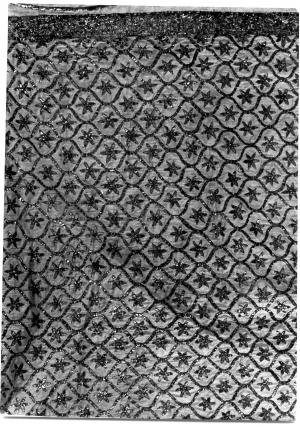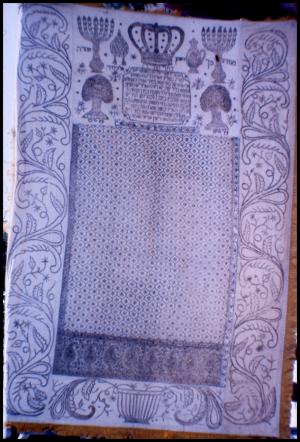Obj. ID: 11317
Sacred and Ritual Objects Parokhet, India, 1914

The rectangular off-white parokhet consists of a central cloth adorned by a dedicatory inscription and an array of Sanctuary Implements, and surrounded on three sides by a floral band.
The Sanctuary Implements surround the inscription, enclosed within a rectangle with concaved corners. It is written in ten lines in square Hebrew letters which reads:
" 'אוהב ה' שערי ציון מכל משכנות יעקב' (תהילים פז:ב)/ מזר"ק (משפחת זרע קדוש?) משל"ע (משהלך לעולמו) זאת הריקמה שפרסו / על ארונו של כה"ר (כבוד הרב) נחמיה בכה"ר (בן כבוד הרב) אהרון הזקן אללה"ה (אלוהים [יזכה אותו] לחיי העולם הבא) / ומנוחתו בליל ש"ק (שבת קודש) יא' לירח אלול ש' (שנת) התרע"ב / ולעילוי נשמתו ולעילוי נשמת בתו הצנועה מ' (מרת) / שמחה שנלב"ע (שנאספה לבית עולמה) ביום ג' לכסליו ש' (שנת) התרע"ג / תנצב"ה (תהי נשמתם צרורה בצרור החיים) הוציאו כסף לעשות את הפרוכת לפני / הק' (הקודש) ליום האדיר בשנה ונשלם מ"ק (מלאכת הקודש) בשנת / ותאזרני שמחה (תהילים ל:יב) והקדישו אותו בניו הי"ו (ה' יחים וישמרם) / לכ"ה (לכבוד התורה) כ"א (כה אמר) ה' בעת רצון עניתיך (ישעיהו מט:ח) אנס"ו (אמן נצח סלה ועד)."
Translation: The Lord loveth the gates of Zion more than all the dwellings of Jacob' (Ps. 87:2), family of the holy seed (?). Since he passed away, this is the embroidery that covered the coffin of the honourable Rabbi Nehemia son of the honourable old Rabbi Aaron, may God grant him the life of the afterworld. And his repose on the evening of the holy Sabbath the 11th of the month of Elul the year 5672 (Saturday, 24.08.1912), and for the exaltation of the his soul and the soul of his modest daughter Mrs. Simha, who passed away on the 3rd of Kislev the year 5673 (13.11.1912), may their souls be bound up in the bonds of life. Money was contributed to make this parokhet (to be displayed) in front of the Holy (Torah ark), on the mightiest day of the year (Yom Kippur - the Day of Atonement), and 'the work of the sanctuary' (based on Ex. 36:4) was completed in the year 'my glory may spring' (Ps. 30:12; the sum of the verse equals to the year 5674 - 1914), and it was consecrated by his sons, may the Lord sustain and protect them, in honour of the Torah. 'Thus saith the Lord, in an acceptable time have I heard thee (and in a day of salvation have I helped thee'; Isa. 49:8), Amen, evermore, Selah, forever."
The inscription is topped by a five-arm crown with a coronet-shape base decorated with rhomboids, and identified by the Hebrew inscription ""כתר תורה "Crown of Torah." Sanctuary Implements are set symmetrically on both sides, each accompanied by a title. In both extreme sides are two seven-branch menorot with round branches formed by foliate motifs (Ex. 25:31). Each of them carries round oil containers with flames. The menorot are supported by an undulating shaft decorated with grooves and a net of rhomboids, and are inscribed "מנורה" "menorah." Two additional Implements are set next to the menorot: on the left a leaf-shape fire tong with two handles (Remarks: no. 1) and the inscription "מלקחיה" "its (the menorah's) fire tongs," while on the right stands an oil jar with a handle and a lid, flanked by the inscription: "פך שמן" "jar of oil." Below the menorot are two trees (Gen. 2:9), identified as the "Tree of Life" ("עץ חיים").
The central cloth is decorated with rounded rhomboids enclosing a six-petal flower. On its lower part is a band decorated with a row of almond shaped leaves (botté), set upon a background of dense open flowers. The main cloth and its lower band are framed by a thin strip bearing a wavy line with flowers.
On the bottom of the parokhet is a vase from which are emerging branches carrying leaves and flowers scrolling upwards. The parokhet is framed by a yellow folded cloth.
- The fire tongs resemble a shovel.
- The inscription indicates that the main central cloth (the longi) was used to cover the coffins and only afterwards was it sewn to the other cloths, and became a parokhet.
sub-set tree:
Israel | Jerusalem | Israel Museum (IM)
| Former Sc.105; now part of the Israel Museum Collection
Embroidery: gilded silver threads in laid and couched embroidery
Additions: paiets
The parokhet is in good condition.
communities. The origin of this custom still needs further research.
Each synagogue kept a wide range of parokhot in various colours. Each colour had significance for a particular holiday or event; thus since red is considered a wedding colour, red parokhot were hung during the Simhat Torah festival, alluding to the allegorical wedding between Israel and the Torah. White parokhot, such as the parokhet described below, were used on the Day of Atonement. The "colour system" also dominates in local customs and costumes.
The off-white parokhet is decorated with Sanctuary Implements, and two Trees of Life, alluding to the Garden of Eden. They flank a dedicatory inscription adorned by a Torah crown.
- Fishof, Iris. Ma'alin Ba'kodesh. Jerusalem: The Israel Museum, 1985. In Hebrew.
- Slepak, Orpah. The Jews of India. Jerusalem: The Israel Museum, 1995.
Israel Museum (IM)















